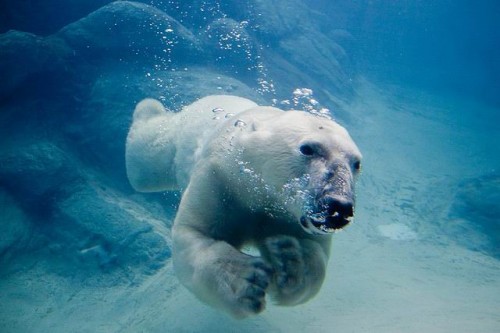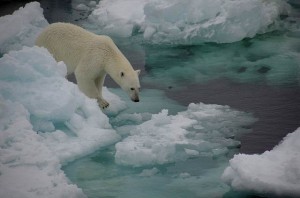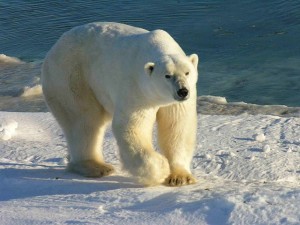 I’d just sat down when the first carver approached me. It was my second evening in Iqaluit on southern Baffin Island, 2000 kilometers north of Ottawa, and all around me well-heeled bureaucrats were tucking into Arctic char and steak. But the carver, a small weathered-looking Inuk, skirted them and made a beeline toward me. In his calloused hands, he held out a small sculpture for sale. It was a bear–a polar bear carved exquisitely from hard green serpentinite. With its long neck stretched and its head lifted, the carved bear tasted the air. Its maker, Jutai Noah, knew his subject intimately.
I’d just sat down when the first carver approached me. It was my second evening in Iqaluit on southern Baffin Island, 2000 kilometers north of Ottawa, and all around me well-heeled bureaucrats were tucking into Arctic char and steak. But the carver, a small weathered-looking Inuk, skirted them and made a beeline toward me. In his calloused hands, he held out a small sculpture for sale. It was a bear–a polar bear carved exquisitely from hard green serpentinite. With its long neck stretched and its head lifted, the carved bear tasted the air. Its maker, Jutai Noah, knew his subject intimately.
As it happened, I had just come back from a nine-day stay in a remote field camp on southern Baffin Island, and I’d just heard a lot about polar bears. Baffin forms a large part of the Canadian Arctic territory of Nunavut, and Nunavut is home, I’m told, to the largest population of polar bears in the world, as many as 15,000 of these large carnivores. But opinions vary wildly on how these legendary bears are doing in Nunavut these days.
 A Canadian federal government committee listed the polar bear as a species of special concern, due to the shrinking sea ice, the favored hunting ground of these carnivores. But the local Inuit I met sure didn’t see things that way. They think the numbers are growing, and they are increasingly alarmed as the bears turn up in their communities.
A Canadian federal government committee listed the polar bear as a species of special concern, due to the shrinking sea ice, the favored hunting ground of these carnivores. But the local Inuit I met sure didn’t see things that way. They think the numbers are growing, and they are increasingly alarmed as the bears turn up in their communities.
An adult polar bear is a patient, clever hunter and it can attack its prey from land, ice or sea. The day I flew into the small Nunavut community of Kimmirut, Veronica Kunilusie showed me snapshots from an afternoon boating trip she and her family had taken near town on the July long weekend. On the water, they encountered a polar bear swimming near an iceberg. Veronica snapped off a few quick photos before her father-in-law gunned the engine of their small boat. No one wanted to stick around.
Young male bears pose the greatest threat to humans. Many can’t compete against bigger, older bears for food, and hunger makes them reckless. In 2001, a young male attacked a group of four hikers just before dawn as they slept in their tents in a park near Kimmirut. The bear badly mauled one of the men, who suffered several broken ribs and a partially detached scalp. He later required 300 stitches. But he was fortunate. Two weeks ago, another early morning attack by a polar bear on a camp of British school boys in the Norwegian Arctic left one boy dead and two others severely injured.
 The archaeologist who directed the dig I visited near Kimmirut was haunted by polar bears. She was a tough, no-nonsense woman who had spent more than 30 years digging in the Arctic, a career littered with close encounters. On a helicopter flight in 2005, she spotted 34 polar bears hunting in the region in just one day: one of her field assistants eventually had to shoot a young male stalking the excavators. She now took no chances. An electric anti-bear fence ringed the tents and an armed Inuit bear-monitor and his dog were up half the night prowling the nearby ridges on lookout duty. Three of the field assistants carried firearms to the dig each day.
The archaeologist who directed the dig I visited near Kimmirut was haunted by polar bears. She was a tough, no-nonsense woman who had spent more than 30 years digging in the Arctic, a career littered with close encounters. On a helicopter flight in 2005, she spotted 34 polar bears hunting in the region in just one day: one of her field assistants eventually had to shoot a young male stalking the excavators. She now took no chances. An electric anti-bear fence ringed the tents and an armed Inuit bear-monitor and his dog were up half the night prowling the nearby ridges on lookout duty. Three of the field assistants carried firearms to the dig each day.
But in the nine days I spent at the camp, no bear wandered into the electric fence and no warning shots were fired. Indeed, no one so much as glimpsed a bear. And even when the archaeologist took to the air in a helicopter survey, she spied just four bears in total in the surrounding countryside.
I was in no great hurry to encounter a polar bear in Nunavut. But I found their absence extremely worrying. The Arctic is warming, and last winter, southern Baffin Island endured a heat wave: temperatures ranged 20 degrees higher than usual some days. This summer the once abundant polar bears around Kimmirut seem to have disappeared, except near town dumps. Has the population moved northward in search of colder habitat? Or have many of the bears starved, far from human eyes, leaving only a few hungry survivors to eke out a living in town dumps? The answers will surely take years of scientific study.
I bought the jade-green carving in the restaurant. I wanted it as a memento, before polar bears become no more than a faint memory to the Inuit of Baffin Island.
Photos/Maps: Swimming Polar Bear, courtesy Irishwildcat on Flickr; Polar bear, courtesy ruchtzwerg’s world; Polar bear, courtesy Ansgar Walk.
But which is it, Heather, more polar bears or fewer? More to the point, isn’t anybody counting them? Inquiring minds are at it again.
Also: gorgeous pictures, and the post is wonderful, as in old-time travelers returning from the wilderness and telling us wondering stay-at-homes about it.
Ann:
Yes, of course, wildlife biologists are out there monitoring polar bear populations in Nunavut, but it is an extremely expensive and time-consuming process to come up with estimates of polar bears scattered across places like remote Baffin Island –the fifth largest island in the world. To come up with good estimates, biologists have to conduct both aerial surveys(generally employing both fixed wing aircraft and helicopters) and mark and recapture studies. So biologists can only conduct surveys of a particular region in Baffin Island every 15 years. The most recent data available for the region I was in–Foxe Basin–comes from research done in the 1980s and 1990s, with some additional data provided in 2004. (See the findings from the Polar Bear Specialist Group at the International Union for Conservation of Nature here: http://pbsg.npolar.no/en/status/status-table.html .) Wildlife biologists have been working on a survey of the Foxe Basin bears since 2007, but the data has yet to be published.
So are there fewer or more polar bears? The scientific data isn’t in. I’m just reporting on what I saw and what I heard in the field on southwest Baffin Island. That evidence suggests there are fewer bears out in the wild, but more frequenting the small town of Kimmirut.
A world without polar bears would be a sad place. I hope they learn to adapt without encroaching on humans too much. Your post brought back memories. My dad used to manage an Alaskan fishing lodge and every summer would bring back soapstone carvings and fresh Arctic Char on ice.